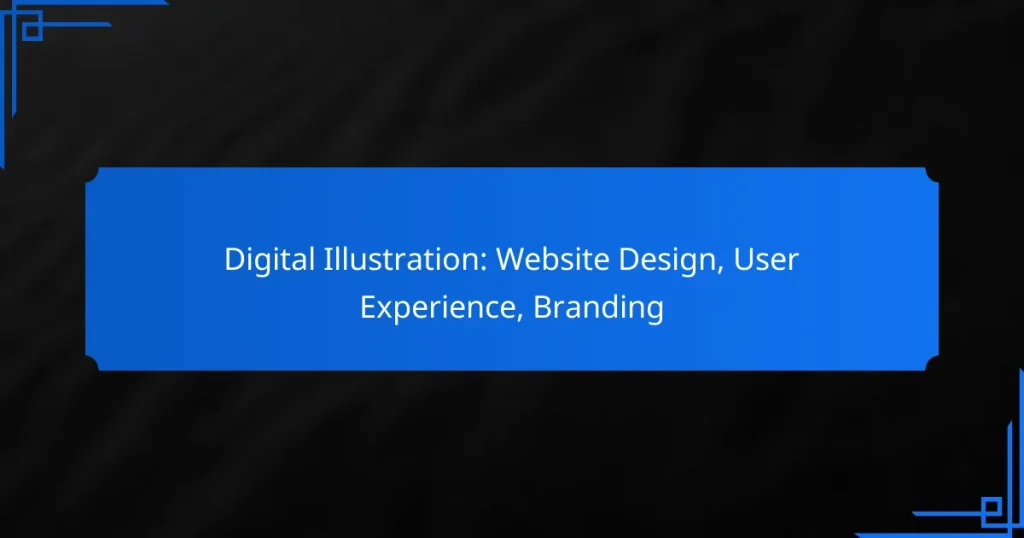Digital illustration plays a crucial role in website design, enhancing visual appeal and effectively conveying messages. By integrating unique illustrations, brands can create a memorable identity that not only captures attention but also improves user experience and fosters emotional connections with audiences.
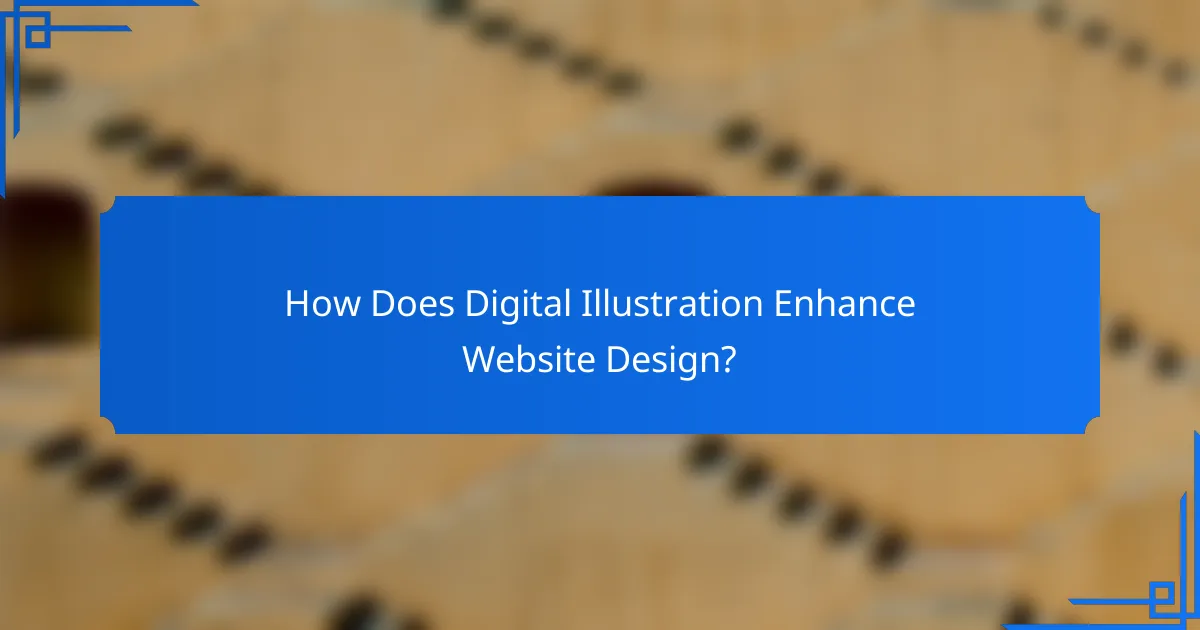
How Does Digital Illustration Enhance Website Design?
Digital illustration significantly enhances website design by adding unique visual elements that capture attention and convey messages effectively. It creates a distinctive aesthetic that can differentiate a brand and improve overall user experience.
Improves visual appeal
Digital illustrations can transform a bland website into an engaging visual experience. They provide a creative way to present information, making it more attractive and memorable for visitors. For instance, custom illustrations can replace stock images, offering a fresh look that aligns with a brand’s identity.
When selecting illustrations, ensure they complement the overall color scheme and design style of the website. Consistency in visual elements helps maintain a cohesive look that enhances the site’s appeal.
Increases user engagement
Incorporating digital illustrations can significantly boost user engagement by making content more interactive and relatable. Engaging visuals can draw users in, encouraging them to spend more time on the site and explore its offerings. For example, animated illustrations can guide users through processes or highlight key features.
To maximize engagement, consider using illustrations that resonate with your target audience. Tailoring visuals to reflect user preferences can lead to higher interaction rates and improved user satisfaction.
Facilitates brand storytelling
Digital illustrations play a crucial role in brand storytelling by visually communicating a brand’s message and values. They can evoke emotions and create connections with users, making the brand more relatable. For instance, a series of illustrations can depict a brand’s journey or mission in a compelling narrative format.
When using illustrations for storytelling, focus on clarity and relevance. Each visual should enhance the narrative and reinforce the brand’s identity, ensuring that users understand the message being conveyed.
Optimizes layout and navigation
Effective use of digital illustrations can optimize website layout and navigation by guiding users through the content. Illustrations can serve as visual cues, helping users understand where to click or what to explore next. For example, icons and directional arrows can clarify navigation paths.
To achieve optimal layout, balance illustrations with text and other elements. Ensure that visuals do not overwhelm the content but instead support a clear and intuitive user journey.
Enhances mobile responsiveness
Digital illustrations can enhance mobile responsiveness by adapting well to various screen sizes and resolutions. Unlike traditional images, illustrations can be scaled without losing quality, ensuring a consistent experience across devices. This adaptability is crucial as more users access websites via mobile devices.
When designing for mobile, prioritize simplicity in illustrations. Clear, concise visuals that load quickly will improve user experience and reduce bounce rates, leading to better overall performance of the website.
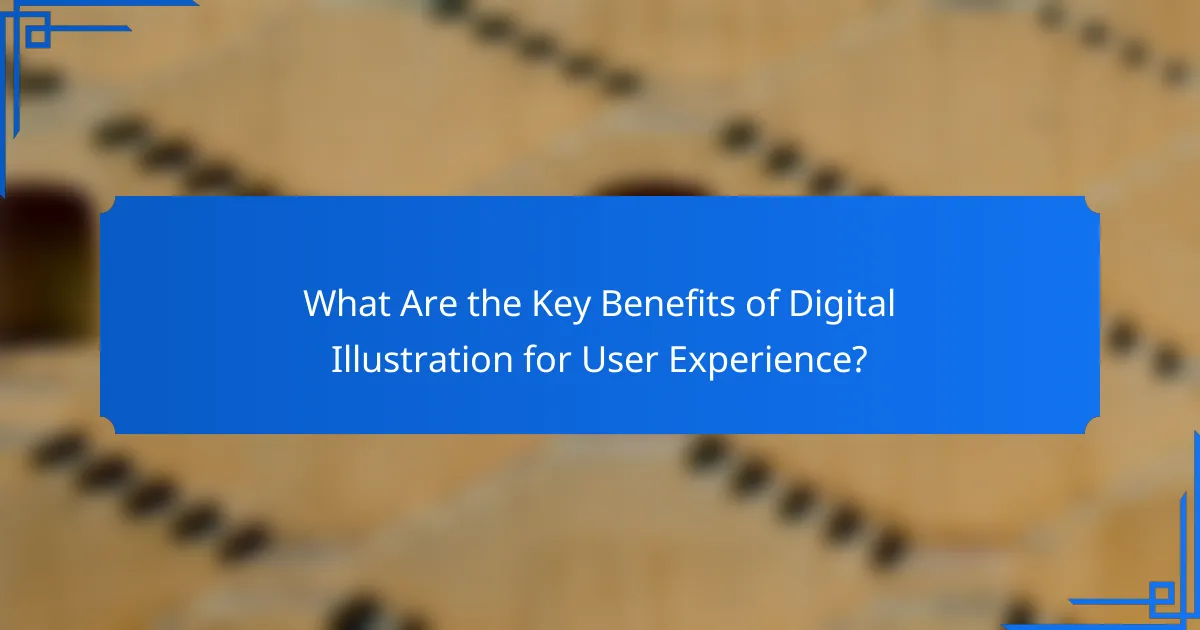
What Are the Key Benefits of Digital Illustration for User Experience?
Digital illustration significantly enhances user experience by making websites more engaging and intuitive. It helps convey messages effectively, leading to improved interaction and satisfaction.
Creates emotional connections
Digital illustrations evoke emotions that resonate with users, fostering a deeper connection with the brand. By using colors, styles, and themes that align with the target audience, businesses can create a memorable visual identity.
For example, a playful illustration style may appeal to younger audiences, while a more sophisticated design can attract professionals. Choosing the right artistic approach is crucial for establishing an emotional bond.
Guides user attention
Illustrations can strategically direct user attention to key elements on a webpage, such as calls to action or important information. By using visual hierarchy, designers can ensure that users notice what matters most.
Employing techniques like contrasting colors or dynamic compositions can enhance focus. For instance, an illustrated arrow pointing towards a sign-up button can effectively draw users’ eyes to that action.
Improves information retention
Visuals are processed faster than text, making digital illustrations an effective tool for enhancing information retention. Users are more likely to remember content that is accompanied by relevant imagery.
Incorporating illustrations alongside textual information can help reinforce key concepts. For example, infographics that combine images and data can significantly boost comprehension and recall.
Reduces cognitive load
Digital illustrations simplify complex information, reducing cognitive load for users. When information is presented visually, it becomes easier to digest and understand.
Using illustrations to break down intricate ideas into digestible parts can enhance clarity. For instance, a step-by-step illustrated guide can make a complicated process feel manageable and straightforward.

How Can Digital Illustration Strengthen Branding?
Digital illustration can significantly enhance branding by creating a unique visual identity that resonates with target audiences. By integrating illustrations into branding strategies, companies can differentiate themselves and foster a deeper emotional connection with consumers.
Establishes brand identity
Digital illustrations help establish a brand identity by visually representing the brand’s personality and values. Unique styles, colors, and themes in illustrations can convey the essence of a brand, making it instantly recognizable.
For example, a playful brand may use bright, whimsical illustrations, while a luxury brand might opt for sleek, minimalist designs. This visual representation aids in creating a memorable impression in the minds of consumers.
Enhances brand recognition
Illustrations can enhance brand recognition by creating distinctive visual elements that stand out in a crowded market. When consumers repeatedly encounter the same illustrations across various platforms, they begin to associate them with the brand.
Using consistent illustration styles in marketing materials, social media, and product packaging can reinforce this recognition. Brands like Airbnb and Dropbox effectively utilize illustrations to create a cohesive visual presence that is easily identifiable.
Conveys brand values
Digital illustrations can effectively convey brand values by visually communicating messages that resonate with the audience. For instance, eco-friendly brands may use illustrations that highlight sustainability and nature, reinforcing their commitment to environmental responsibility.
Choosing the right imagery can evoke emotions and align with the target audience’s values, making the brand more relatable. This connection can lead to increased loyalty and trust among consumers.
Supports cohesive visual language
A cohesive visual language is crucial for effective branding, and digital illustrations play a key role in achieving this. By maintaining a consistent style, color palette, and theme across all visual content, brands can create a unified experience for their audience.
To ensure cohesion, brands should develop guidelines for their illustrations, detailing the preferred styles and applications. This approach helps maintain consistency across various platforms, from websites to social media, enhancing overall brand perception.
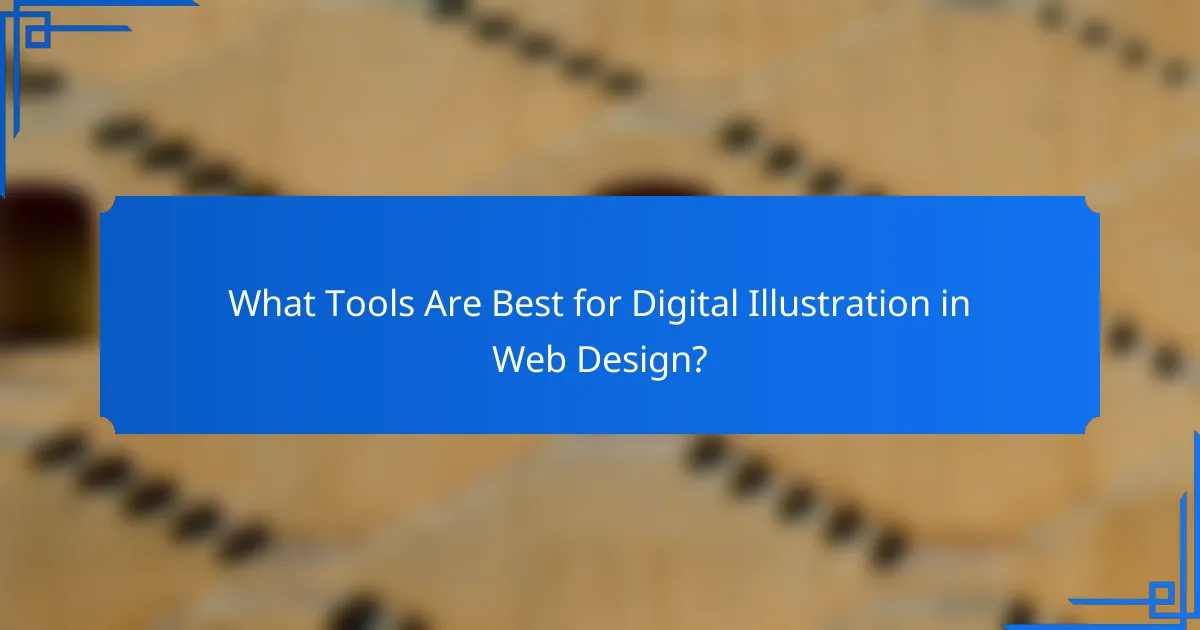
What Tools Are Best for Digital Illustration in Web Design?
For digital illustration in web design, tools like Adobe Illustrator, Procreate, Figma, and Affinity Designer are among the best options available. Each tool offers unique features that cater to different aspects of design, from vector graphics to collaborative interfaces.
Adobe Illustrator
Adobe Illustrator is a leading vector graphics editor widely used for creating scalable illustrations. It provides powerful tools for drawing, typography, and color management, making it ideal for logos, icons, and complex illustrations.
When using Illustrator, consider its extensive library of brushes and effects to enhance your designs. However, be mindful of the learning curve; beginners may find it challenging to navigate all its features effectively.
Procreate
Procreate is a popular digital painting app designed for the iPad, favored by illustrators for its intuitive interface and extensive brush library. It allows for a natural drawing experience, making it suitable for detailed artwork and sketches.
While Procreate excels in freehand illustration, it may not be the best choice for vector-based designs. Users should also ensure they have an iPad compatible with the app, which can be a significant investment.
Figma
Figma is a collaborative design tool that enables teams to work together in real-time on web and interface designs. It supports vector graphics and is particularly useful for UI/UX projects, allowing for easy prototyping and feedback integration.
Utilizing Figma can streamline the design process, especially for teams. However, it may lack some advanced illustration features found in dedicated software like Illustrator, so it’s best for interface design rather than detailed illustrations.
Affinity Designer
Affinity Designer is a cost-effective alternative to Adobe Illustrator, offering robust vector and raster design capabilities. It is suitable for both web and print design, providing a versatile platform for various projects.
One of its advantages is the one-time purchase model, making it more budget-friendly compared to subscription-based services. However, users should be aware that while it has a strong feature set, it may not have the same level of community support and resources as Adobe products.
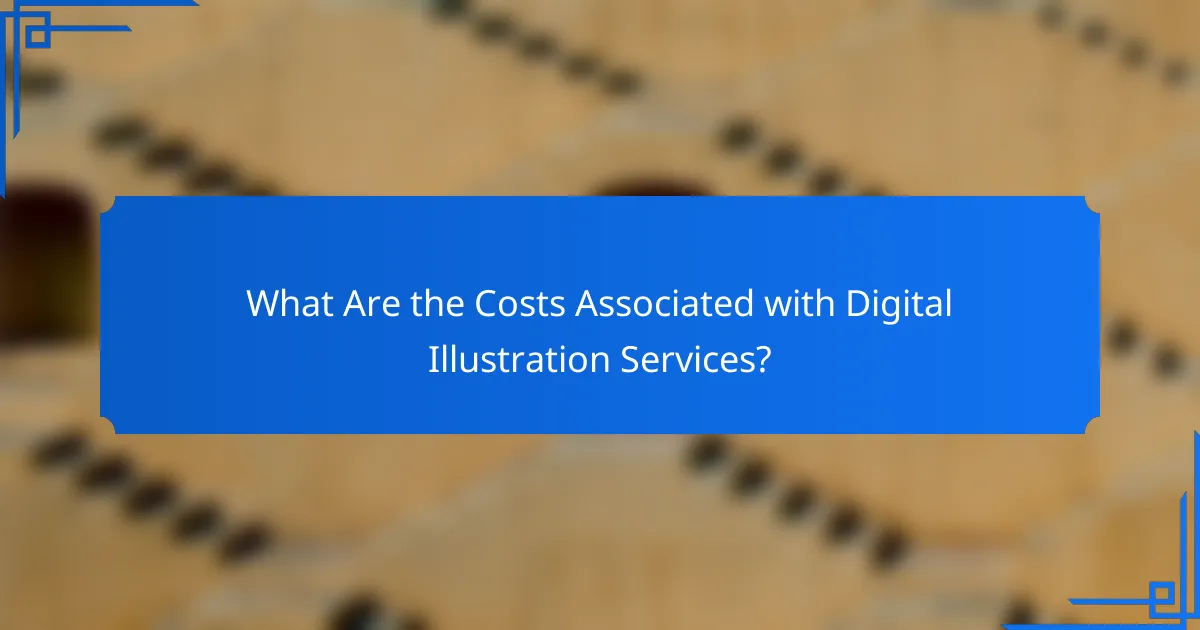
What Are the Costs Associated with Digital Illustration Services?
The costs associated with digital illustration services can vary significantly based on factors such as the illustrator’s experience, the complexity of the project, and the time required to complete it. Understanding these costs is essential for budgeting and ensuring you get the right value for your investment.
Freelance rates
Freelance digital illustrators typically charge hourly rates or project-based fees. Hourly rates can range from around $25 to $150 or more, depending on the illustrator’s skill level and reputation. For project-based pricing, simpler illustrations may cost a few hundred dollars, while more complex works can reach into the thousands.
When hiring a freelancer, consider their portfolio and client reviews to gauge their expertise. It’s also wise to discuss the scope of work upfront to avoid unexpected costs later on.
Agency pricing models
Agencies often have structured pricing models that can include flat fees, retainers, or hourly rates. The cost of hiring an agency for digital illustration services usually starts at several hundred dollars and can go up to several thousand, depending on the project’s scale and the agency’s reputation.
Agencies may provide additional services, such as project management and collaboration with other creatives, which can justify higher costs. However, ensure that you clarify what is included in the price to avoid misunderstandings.
